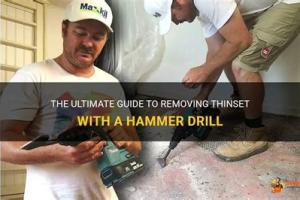The Ultimate Guide to Removing Thinset from Concrete, Wood, & More

-
Quick Links:
- Introduction
- Understanding Thinset
- Essential Tools and Materials
- Removing Thinset from Concrete
- Removing Thinset from Wood
- Removing Thinset from Other Surfaces
- Step-by-Step Guide
- Case Studies and Real-World Examples
- Expert Insights
- Safety Tips
- FAQs
Introduction
Thinset is a common adhesive used in tile installation, particularly for flooring. While it serves its purpose well, removing it can be a daunting task for both DIY enthusiasts and professionals. This comprehensive guide will walk you through various methods of removing thinset from different surfaces, including concrete, wood, and more.
Understanding Thinset
Thinset is a blend of cement, fine sand, and a water-retaining agent. It is typically used to adhere tiles to floors and walls. Understanding its composition and the properties of thinset is essential for effective removal.
Types of Thinset
- Standard Thinset
- Modified Thinset
- Rapid-Setting Thinset
Essential Tools and Materials
Before you begin removing thinset, gather the necessary tools and materials:
- Chisel or Scraper
- Pry Bar
- Hammer
- Angle Grinder with Diamond Blade
- Floor Buffing Machine (optional)
- Wet/Dry Vacuum
- Protective Gear (gloves, goggles, mask)
- Water (for wet methods)
Removing Thinset from Concrete
Removing thinset from concrete can be labor-intensive but is achievable with the right approach.
Methods for Concrete Thinset Removal
- Scraping: Using a chisel or scraper for small areas.
- Grinding: Utilizing an angle grinder for larger areas.
- Wet Removal: Soaking the thinset to soften it before scraping.
Removing Thinset from Wood
Removing thinset from wood surfaces requires more caution to prevent damage.
Steps to Remove Thinset from Wood
- Use a chisel with a gentle angle to avoid gouging the wood.
- Soak the thinset with water if it’s particularly stubborn.
- Consider using a heat gun to soften the adhesive before scraping.
Removing Thinset from Other Surfaces
Different materials may require unique approaches to thinset removal.
Common Surfaces
- Tile: Use a chisel carefully to avoid breaking the tiles.
- Vinyl: A heat gun can help soften the thinset for easier removal.
Step-by-Step Guide
Here’s a detailed step-by-step approach for removing thinset effectively:
Step 1: Assess the Surface
Determine the type of surface and the method of thinset application.
Step 2: Prepare the Area
Clear the workspace and ensure you have proper ventilation.
Step 3: Choose Your Method
Select the appropriate method based on the surface type.
Step 4: Execute the Removal
Follow the chosen method, ensuring to take safety precautions.
Case Studies and Real-World Examples
Real-world applications provide insight into various methods of thinset removal:
Case Study 1: Concrete Floor Removal
A homeowner used an angle grinder to remove thinset from a concrete floor effectively, saving hours of labor compared to manual scraping.
Case Study 2: Wooden Subfloor
A contractor employed a heat gun to soften thinset on a wooden subfloor, minimizing damage and ensuring a smooth finish for new flooring.
Expert Insights
We reached out to industry experts for their thoughts on effective thinset removal:
"Always start with the least invasive method to preserve the underlying surface. Patience is key!" - Jane Doe, Flooring Specialist
Safety Tips
When engaging in thinset removal, prioritize safety:
- Wear protective goggles to shield your eyes from debris.
- Use a mask to avoid inhaling dust.
- Ensure adequate ventilation, especially when using power tools.
FAQs
1. What is thinset?
Thinset is a cement-based adhesive used to fix tiles to floors and walls.
2. Can I remove thinset without power tools?
Yes, manual methods like scraping can be used, but they may require more effort.
3. Is it necessary to wear protective gear?
Absolutely, protective goggles and masks are vital for safety during removal.
4. How long does thinset take to dry?
Thinset typically takes 24-48 hours to cure, depending on the conditions.
5. Can I use vinegar to remove thinset?
Vinegar can help soften thinset, but it may not be effective on all surfaces.
6. What’s the best way to soften thinset?
Soaking it with water or using a heat gun can soften thinset for easier removal.
7. How do I know if all the thinset is removed?
Check the surface for smoothness and the absence of residue.
8. Is it possible to damage the substrate while removing thinset?
Yes, improper techniques can damage the underlying surface, especially wood.
9. Can I reuse the substrate after removing thinset?
Yes, if the substrate is intact and clean, it can often be reused for new flooring.
10. Are there professional services for thinset removal?
Yes, many flooring professionals offer thinset removal as part of their services.
Random Reads
- How to thaw a frozen pipe
- How to find google password android iphone
- How to transfer files linux servers
- How to transfer files from phone to pc or mac
- How to switch monitors 1 and 2
- How to copy save files to another wii
- How to copy wii games
- Mastering statistics mean standard deviation standard error
- Can linux run exe files
- Can you find a dead apple watch